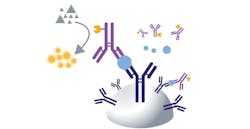Immunoassay—Past innovations and future potential in diagnostic medicine
Immunoassays, biochemical tests used to detect the presence of an analyte—antibody or antigen—using labeled antibodies, are used to aid in the diagnosis of diseases from infectious diseases such as HIV to neurodegenerative diseases such as Alzheimer’s Disease. This essential, cost-effective technology can be found in diagnostics laboratories around the world. New research demonstrates the potential of breakthrough innovations in immunoassay that can accelerate diagnosis and improve clinical outcomes. Although the immunoassay (IA) was invented over 65 years ago,1 the technology, along with the implementation of the technology, has continuously evolved. Current state-of-the-art embodiments of IA on fully automated analyzers can deliver highly sensitive results in a timely and consistent manner, which greatly facilitate the ability to diagnose and manage disease. The progression from that earliest radioimmunoassay (RIA), which could take days to deliver a result, to the current assays, which can be completed in minutes, has been steady; however, certain inventions stimulated quantum leaps forward in the technology. The most notable paradigm shifts in IA were from the inventions of monoclonal antibodies,2 enzyme mediated amplification,3 paramagnetic microparticles,4 and chemiluminescence5 (including all the various forms of triggering—e.g., enzymatically, chemically, electrochemically).
Advancements in IA
Enzyme mediated amplification of immunoassay (EIA) utilizes the catalytic capability of an enzyme to act on a substrate to cause a detectable, quantifiable signal change. A common version of EIA implemented in microtiter plate assays is the use of horse radish peroxidase (HRP) and the substrates hydrogen peroxide and tetramethylbenzidine (TMB). HRP rapidly catalyzes the oxidation of the TMB by the reduction of hydrogen peroxide to create a blue color that can be easily measured. The major advancement afforded by EIA was to make IA much more accessible through the elimination of radioisotopes and all their associated negatives (health, storage, etc.). The introduction of paramagnetic microparticles (PMP) greatly facilitated the ability to automate IA. Due to the small size of the particles (and the iron particles contained within) the particles could be easily suspended, separated in a magnetic field, then resuspended, making them ideal for automation. Advances in the surface chemistries of the PMP have helped to allow convenient covalent attachment of specific proteins (e.g., capture monoclonal antibodies) and minimized non-specific adsorption.
Chemiluminescence, one of the most recent advancements in IA, has dramatically elevated the level of sensitivity that can be achieved. Chemiluminescence is the generation of light—since there is no light generation in biological samples (low background) and there are very good methodologies available for detecting light (high sensitivity)—chemiluminescence, when properly implemented, can push the limits of detection to levels not readily achievable with other technologies.
As advanced as IA has become, there is still significant progress being made. Continual efforts, incorporating the latest scientific advancements, are directed toward improving sensitivity, shortening time-to-results, minimizing variability, increasing robustness, improving safety, and making IAs more sustainable. It is possible that some of these advances will be considered as paradigm shifts when reflected upon by future generations.
Monoclonal antibody to recombinant expression platforms
Another significant shift in immunoassay technology was the implementation of monoclonal antibodies (mAbs), which allowed one specific antibody to be produced, purified, and incorporated in the IA. Until this breakthrough, all IAs used either polyclonal antisera, total polyclonal antibody, or antigen-specific affinity purified antibody. The introduction of mAbs brought a level of specificity and reproducibility that had not been readily achievable with polyclonals and removed the reliance on a specific polyclonal-producing animal.
Recent advancements in monoclonal antibody development and production have moved production from traditional hybridoma methods to recombinant expression platforms. Traditional hybridoma technology is labor intensive and relies upon an inherently variable biological system, which may not grow or produce an antibody sufficiently well to support large-scale monoclonal antibody production. These limitations resulted in hurdles to obtaining high-quality, highly specific, and sensitive monoclonal antibodies that function well in immunoassay formats. Recombinant technologies, on the other hand, build from the base knowledge of the genetic makeup of the protein (in this case a mAb) and utilize a high-expression host cell system, such as Chinese Hamster Ovary (CHO) or Human Embryonic Kidney (HEK) cell lines, to express the protein at higher levels and in a more consistent and controlled environment (for a review on recombinant antibody production, please see Kunert and Reinhart6).
In addition to improvements in yield, cost, and manufacturability / scale-up, the shift to recombinant production techniques has also opened doors to myriad strategies not only for novel techniques in antibody discovery, but also for protein engineering; that is, modifying the antibody at a genetic level to achieve improvements in expression, or function, processing, or even to create fusion proteins with multiple functions.
Advancements in antibody discovery and engineering
In the field of antibody discovery, recombinant approaches have enabled the following: rapid evaluation of thousands of antibodies directly from the B-cells of immunized animals, without the need for hybridoma formation and screening; sequencing of monoclonal antibodies from hybridoma cell lines that either can no longer support the manufacturing scale required or even that are no longer recoverable from cryopreservation, thereby “rescuing” mAbs that may have otherwise been lost forever; creation of antibodies from libraries of binders from novel species (e.g., camelid VHH phage libraries); and more.
Antibody engineering involves manipulation of the amino acid sequence of the antibody at the genetic level. One application of antibody engineering is affinity-maturation, in which numerous point mutations (single amino acid substitutions) may be evaluated to improve antibody performance. Another application is isotype or subtype swapping, where, for example, an IgG1,k antibody can be converted to an IgG2a,l antibody without impacting the antibody’s binding profile.7 Further, the constant region of an antibody can be changed to a different species; for example, a mouse IgG antibody may be converted into a chimera antibody containing the mouse variable regions and human constant regions,8,9 which may result in favorable performance improvements. Tags can be added to proteins to facilitate purification or other downstream processing, or fusion proteins can be created that provide unique binding partners. These are just a few examples of the vast and ever-expanding sets of tools that immunoassay developers can leverage to build higher quality, more sensitive, and faster immunoassays.
AI-powered research & development enabling future breakthrough
Above, we briefly touched on some of the efforts underway to improve the “I” (immune) part of the IA, but that is just one piece of a much larger puzzle. There is groundbreaking work on every aspect of the IA process including not only the assay but also instrumentation and analysis software incorporating the latest developments in science and engineering. For example, chemists are actively trying to create chemiluminescent substrates with a higher quantum efficiency that generate significantly more light. New detection technologies continue to be developed—an interesting example is direct mass detection using thin-film acoustic resonators that are an off-shoot of the cell phone industry. Newer instruments include the latest monitoring technologies to ensure all steps in the process are completed as intended.
An exciting, more recent advancement is the implementation of artificial intelligence (AI). In one embodiment, researchers are using AI to improve diagnosis of neurological diseases such as Alzheimer’s, Parkinson’s, and amyotrophic lateral sclerosis (ALS),10,11 (for a review on using AI in neurodegenerative diseases, please see Tăuţan et al.12), which are extremely difficult to diagnose in their early stages when treatment may be more effective. Another key area of AI implementation is in the de novo design of specific binding proteins (here, antibodies, for a review of AI-guided antibody design see Gallo13 and Kim et al.14).
Can AI design a binding protein with the same affinity and specificity as Mother Nature? Not yet, but it would be foolish to bet against this eventuality. Did Drs. Benson and Yarlow realize in 1959 what their invention would lead to? Did the Nobel Prize committee realize in 1977 when it awarded the Medicine prize for this work how IA would continue to help revolutionize modern medicine for the next 46 years? There does not appear to be an end or a limit in sight for IA. While both the “I” and the “A” continue to evolve, the need to specifically measure biomolecules will most likely remain constant. Efforts underway today continue to build on the rich scientific history associated with IA, helping to improve everyone’s quality of life.
References
- YALOW RS, BERSON SA. Assay of plasma insulin in human subjects by immunological methods. Nature. 1959;21;184 (Suppl 21):1648-9. doi:10.1038/1841648b0.
- Köhler G, Milstein C. Continuous cultures of fused cells secreting antibody of predefined specificity. Nature. 1975;256(5517):495-497. doi:10.1038/256495a0.
- Engvall E, Perlmann P. Enzyme-linked immunosorbent assay (ELISA). Quantitative assay of immunoglobulin G. Immunochemistry. 1971;8(9):871-874. doi:10.1016/0019-2791(71)90454-X.
- Richardson J, Hawkins P, Luxton R. The use of coated paramagnetic particles as a physical label in a magneto-immunoassay. Biosens Bioelectron. 2001;16(9-12):989-93. doi:10.1016/s0956-5663(01)00201-9.
- Velan B, Halmann M. Chemiluminescence immunoassay; A new sensitive method for determination of antigens. Immunochemistry. 1978;15(5):331-333. doi:10.1016/0161-5890(78)90094-9.
- Kunert R, Reinhart D. Advances in recombinant antibody manufacturing. Appl Microbiol Biotechnol. 2016;100(8):3451-3461. doi:10.1007/s00253-016-7388-9.
- Lua W-H, Ling W-L, Yeo JY, et al. The effects of Antibody Engineering CH and CL in Trastuzumab and Pertuzumab recombinant models: Impact on antibody production and antigen-binding. Sci Rep. 2018;8(1):718. doi:10.1038/s41598-017-18892-9.
- Neuberger MS, Williams GT, Fox RO. Recombinant antibodies possessing novel effector functions. Nature. 1984;312(5995):604-608. doi:10.1038/312604a0.
- Morrison SL, Johnson MJ, Herzenberg LA, Oi VT. Chimeric human antibody molecules: mouse antigen-binding domains with human constant region domains. Proc Natl Acad Sci USA. 1984;81(21):6851-6855. doi:10.1073/pnas.81.21.685.
- Kavungal D, Magalhães P, Kumar ST, Kolla R, Lashuel HA, Altug H. Artificial intelligence-coupled plasmonic infrared sensor for detection of structural protein biomarkers in neurodegenerative diseases. Sci Adv. 2023;9(28):eadg9644. doi:10.1126/sciadv.adg9644.
- Bakkar N, Kovalik T, Lorenzini I, et al. Artificial intelligence in neurodegenerative disease research: use of IBM Watson to identify additional RNA-binding proteins altered in amyotrophic lateral sclerosis. Acta Neuropathol. 2018;135(2):227-247. doi:10.1007/s00401-017-1785-8.
- Tăuţan A-M, Ionescu B, Santarnecchi E. Artificial intelligence in neurodegenerative diseases: A review of available tools with a focus on machine learning techniques. Artif Intell Med. 2021;117:102081. doi:10.1016/j.artmed.2021.102081.
- Gallo E. Revolutionizing synthetic antibody design: harnessing artificial intelligence and deep sequencing big data for unprecedented advances. Mol Biotechnol. February 3, 2024. doi:10.1007/s12033-024-01064-2.
- Kim DN, McNaughton AD, Kumar N. Leveraging Artificial Intelligence to Expedite Antibody Design and Enhance Antibody-Antigen Interactions. Bioengineering (Basel). 2024;11(2). doi:10.3390/bioengineering11020185.
About the Author

Michael Salvati, MS
is a Principal Scientist for Beckman Coulter Diagnostics Division in Chaska, MN. He evaluates technologies and designs/develops both reagents and assays.

Jason Owens, PhD
is a Senior Staff Development Scientist for Beckman Coulter Diagnostics Division in Chaska, MN. He evaluates technologies and designs/develops both reagents and assays.
